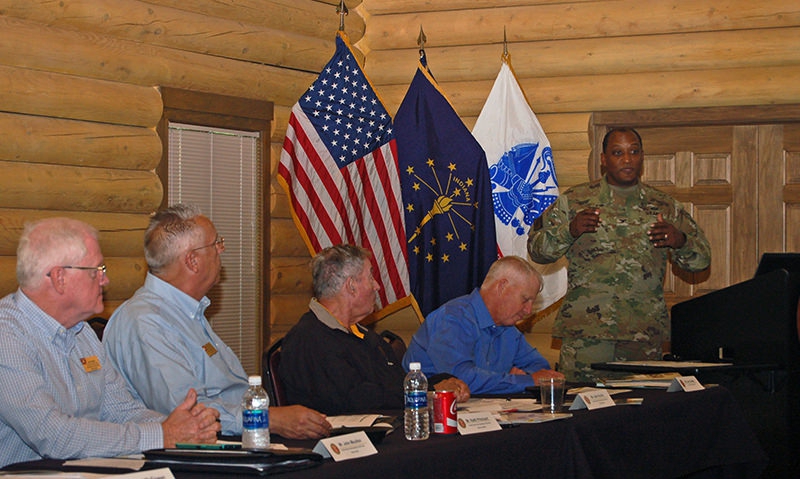
Readiness, force strength and the Army's balancing act
Civilian Aides to the Secretary of the Army from across the Midwest and beyond gathered this week at one of America's most unique military training grounds and grappled with a complication that can’t be ignored in the era of sequestration, force reduction and war.
“The number of full-time soldiers in our force definitely has an impact on readiness,” Indiana Army National Guard Adjutant Maj. Gen. Courtney Carr told CASAs who gathered at Camp Atterbury in central Indiana Tuesday and Wednesday for a regional conference. He said 19 percent of the 13,650 men and women in the Indiana Army and Air National Guard, fourth largest National Guard contingent in the nation, are full time, and more are needed to keep up with training and operational demands. “Some folks don't understand what the full-time force does.” A primary function, he explained, is readying facilities for training exercises.
Increased wartime pressure on National Guard and Army Reserve components to quickly mobilize means increased training time for soldiers. Guardsmen, Reservists and their employers “do pick up an additional burden," Maj. Gen. Carr said. And, he added, "without full-time staff, there is no drill weekend.”
Maj. Gen. Carr added that private-sector employers are not always willing or able to accommodate heightened National Guard and Reserve training commitments and deployments. He said the Employer Support of the Guard and Reserve (ESGR) program is essential to help bridge that gap, which can affect recruitment and retention alike for personnel with families to support.
The theme of Tuesday's conference sessions centered largely on the challenges of recruitment, retention and readiness – active-duty, National Guard and Reserve alike. "We are all trying to recruit the same person," said Lt. Col. Kevin Polosky of the Army’s Nashville Recruiting Battalion. "The question is how do we work together?"
American Legion Past National Commander and Past National Adjutant Robert W. Spanogle, CASA for Indiana and organizer of the conference, said recruiters should not only be marketing the Army to potential recruits but to their families, as well, on the basis of long-term benefits, such as college education. “Influencers are fathers and mothers, aunts and uncles and grandparents,” Spanogle said, adding that family members probably do not have a clear and updated understanding of the opportunities available through military service today. “The opportunities are far greater now than they used to be. Influencers at the kitchen table need to know about the opportunities.” He said the Army can help families by providing succinct lists of benefits and incentives of military service, such as college scholarships for National Guard and Reserve students, and GI Bill provisions for veterans.
Kenneth Wong, CASA from Pennsylvania, said the high cost of college education prevents many students from finishing. Assistance like Minutemen Scholarships and March to Success programs can help those who choose National Guard or Reserve duty during their college years. “Every college has a retention problem,” Wong said. “There are many ways CASAs can assist (through promotion of scholarships). The days of not thinking outside the box are gone.”
Camp Atterbury and nearby Muscatatuck Urban Training Center – a 1,000-acre simulated city that is used to train troops ranging from U.S. special operations units to allied Slovakians whose readiness program has grown substantially due to Russian military activity in eastern Europe – are nationally recognized, state-of-the-art installations for combat preparation. The Indiana National Guard also recently inked an official training agreement with the U.S.-allied Nigerian military, which faces significant threats from ISIS in a nation bordered by Libya and Algeria.
The CASAs toured both facilities during the conference, including marksmanship, vehicle convoy and medical training simulators, cyber capabilities and urban warfare instruction at Muscatatuck.
With tensions mounting in North Korea, China, Africa and eastern Europe – in addition to ongoing wartime operations to defeat ISIS in the Middle East – the challenge of increasing end strength and paying for equipment modernization is a difficult balancing act, especially in the era of sequestration, Col. Patrick Lamb told the CASAs. “Readiness is our first priority; we have to defend the nation,” he said. “The challenge is the trade-off.” He said increased funding for force strength typically means compromised funding for weapons, aircraft, ships and equipment.
Col. Lamb, an American Legion Boys State and Boys Nation alum from New Mexico, added that continuing budget resolutions, which hold defense spending to the previous year’s levels while Congress deliberates over a final federal budget for the fiscal year, delays the Army’s ability to build and replenish necessary warfighting equipment.
Also during the conference, the CASAs received briefings on the Naval Surface War Center at Crane, Ind.; an overview of the Army Corps of Engineers-Louisville District’s projects now underway; and the Army Wellness Center program, which is effectively improving physical fitness for soldiers in many parts of the country.
